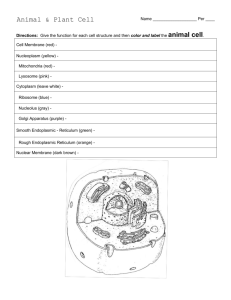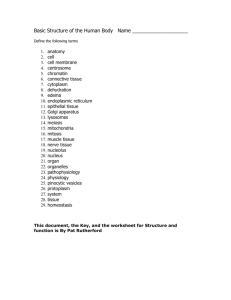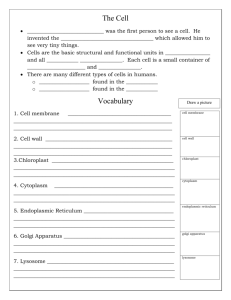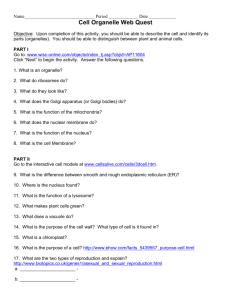Cell is the universal functional unit of all forms of life. On the basis of
advertisement
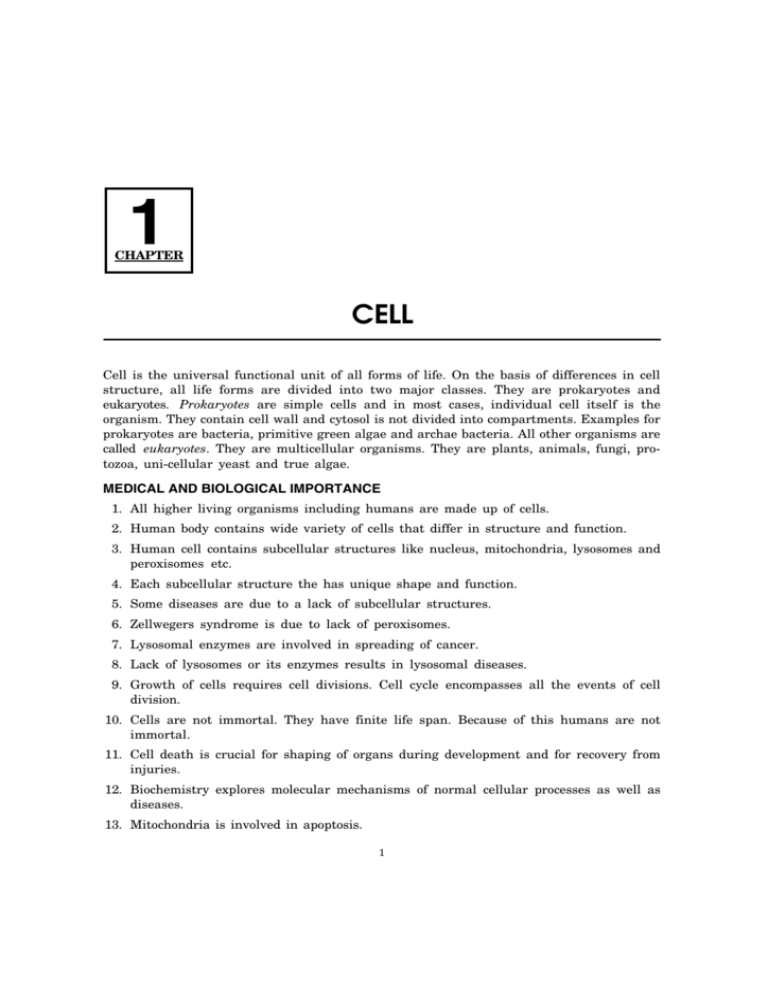
1 CHAPTER CELL Cell is the universal functional unit of all forms of life. On the basis of differences in cell structure, all life forms are divided into two major classes. They are prokaryotes and eukaryotes. Prokaryotes are simple cells and in most cases, individual cell itself is the organism. They contain cell wall and cytosol is not divided into compartments. Examples for prokaryotes are bacteria, primitive green algae and archae bacteria. All other organisms are called eukaryotes. They are multicellular organisms. They are plants, animals, fungi, protozoa, uni-cellular yeast and true algae. MEDICAL AND BIOLOGICAL IMPORTANCE 1. All higher living organisms including humans are made up of cells. 2. Human body contains wide variety of cells that differ in structure and function. 3. Human cell contains subcellular structures like nucleus, mitochondria, lysosomes and peroxisomes etc. 4. Each subcellular structure the has unique shape and function. 5. Some diseases are due to a lack of subcellular structures. 6. Zellwegers syndrome is due to lack of peroxisomes. 7. Lysosomal enzymes are involved in spreading of cancer. 8. Lack of lysosomes or its enzymes results in lysosomal diseases. 9. Growth of cells requires cell divisions. Cell cycle encompasses all the events of cell division. 10. Cells are not immortal. They have finite life span. Because of this humans are not immortal. 11. Cell death is crucial for shaping of organs during development and for recovery from injuries. 12. Biochemistry explores molecular mechanisms of normal cellular processes as well as diseases. 13. Mitochondria is involved in apoptosis. 1 2 Medical Biochemistry 14. Endoplasic reticulum, lysosomes and golgi complex are involved in the integration of pro-apoptic signals. MOLECULAR COMPOSITION OF CELL Water Water accounts for about 70-75% of the weight of the cell. Other cellular constituents are either dissolved or suspended in water. Organic Compounds 1. Organic compounds accounts for 25-30% of the cell weight. 2. They are nucleic acids, proteins, polysaccharides (carbohydrates) and lipids. Proteins accounts 10-20% of the weight of the cell. Nucleic acids account 7-10% of the cell weight. Polysaccharides usually account for 2-5% of the cell weight. About 3% of cell weight is due to lipids. Lipids content may be higher in adipocytes or fat cells. Proteins may account more of cell weight in cells like erythrocytes. 3. Other low molecular weight organic compounds may account for 4% of cell weight. They are monosaccharides, aminoacids, fatty acids, purine and pyrimidine nucleotides, peptides, hormones, vitamins and coenzymes. Inorganic Compounds 1. Inorganic compounds account for the rest of the cell weight. 2. They are cations like sodium, potassium, calcium, magnesium, copper, iron and anions like chloride, phosphate, bicarbonate, sulfate, iodide and fluoride. EUKARYOTIC CELL STRUCTURE AND FUNCTION In eukaryotes, cells aggregate to form tissues or organs and these are further organized to form whole organism. In humans, eukaryotic cells exist in large number of sizes and shapes to perform varieties of functions. For example, nerve cells differ from liver cell which differ from muscle cell and they differ in function also. Though the eukaryotic cells differ in sizes and shapes they have certain common structural features. Further, eukaryotes contain subcellular structures and well defined nucleus. Cells are surrounded by membranes. It separates the cells from surrounding and it is called as plasma or cell membrane. The other subcellular organelles are also composed in parts by membranes. A typical eukaryotic cell is shown in Figure 1.1. SUBCELLULAR STRUCTURES AND THEIR FUNCTIONS Cell Membrane Structure 1. The outermost structure of the cell that decides its contour is the cell membrane. 2. It is a lipid bi-layer. It also consist of proteins and small amounts of carbohydrates (Figure 1.1 a). Cell 3 Fig. 1.1 (a) Cell membrane Functions 1. It is fluid and dynamic. 2. It is semi permeable, only selected compounds are allowed to pass through from outside. The selective permeability is responsible for the maintenance of internal environment of the cell and for creating potential difference across the membrane. 3. The modification of the cell membrane results in formation of specialized structures like axon of nerves, microvilli of intestinal epithelium and tail of spermatids. Nucleus Structure 1. Centre of the cell is nucleus. 2. It is surrounded by double-layer membrane of about 250-400 Å thick. 3. The two layers of nuclear membrane are an outer and inner membrane (layer). The two membranes fuse periodically to produce nuclear pores. Exchange of material between nucleus and rest of the cell occurs through nuclear pores. 4. The outer nuclear membrane continuous with other cytomembranes. In some eukaryotic cells, like erythrocyte nucleus is absent. In spermatozoa, nucleus accounts for 90% of cell whereas in other cells nucleus accounts for less than 10% of the cell. In prokaryotes, nucleus is not well defined. Functions 1. Nucleus is the information centre of eukaryotic cell. More than 90% of the cellular DNA is present in the nucleus. It is mainly concentrated in the form of chromosomes. 4 Medical Biochemistry 2. Human cell contains 46 chromosomes. These chromosomes are composed of nucleoprotein chromatin, which consist of DNA and proteins histones. Some RNA may also present in the nucleus. 3. In prokaryotes, the DNA is present as thread in the cytosol. Nucleolus Structure and Function These are small dense bodies present in the nucleus. Their number varies from cell to cell. There is no membrane surrounding them. They are continuous with nucleoplasm. Protein accounts for 80% of nucleolus remainder is DNA and RNA. Nucleoplasm It is also called as nuclear matrix. It contains enzymes involved in the synthesis of DNA and RNA. Cytosol, Cytoplasm or Cell Sap Structure 1. The extra nuclear cell content that possess both orgenelles and other material constitutes cytoplasm. Material other than subcellular components in the cytoplasm makes up the cytosol or cell sap. 2. Sometimes soluble portion of the cell is referred as cytosol. Cytoplasm accounts for 70-75% weight of the cytosol. Functions 1. Numerous enzymes, proteins and many other solutes are found in cytosol. 2. Cytosol is the main site for glycolysis, HMP shunt, activation of aminoacids and fattyacid synthesis. Mitochondria Structure 1. Are the second largest structures in the cell. 2. Generally mitochondria are ellipsoidal in shape and can assume variety of shapes. 3. The length of a mitochondrion is about 7 microns and has a diameter of 1 micron. 4. Mitochondria consist of outer and inner membranes. The outer membrane is composed of equal amount of protein and lipids. 5. The lipids are mainly phospholipids and cholesterol. The outer membrane functions as a limiting membrane and permeable to many compounds. 6. The inner membrane consist of 75% protein and remainder is lipid. 7. Cardiolipin is the important phospholipid of inner mitochondrial membrane. 8. The inner membrane is convoluted to form number of invaginations known as cristae extending to matrix (Figure 1.1b). 9. These cristae are covered with knob like structures, which are composed of head piece, stalk and a base piece. Cell 5 Functions 1. The number of mitochondria ranges from 1-100 per cell depending on type of cell and its function. Several factors influence the size and number of mitochondria in cells. In yeast, mitochondria is present in aerobic state and absent in anaerobic state. Exposure to cold increases mitochondria by 20-30% in liver cells. 2. In highly metabolically active cells mitochondria are more and large. 3. Location of mitochondria in cell also depends on types and functions of cell. In liver cell mitochondria are scattered. In muscles they are parellely arranged. Mitochondria in liver cell may range up to 2000 whereas in kidney they may range up to 300. 4. Mitochondria is the power house of the cell. It is responsible for the production of energy in the form of ATP. The knob like structures function in electron transport and oxidative phosphorylation. 5. Mitochondria also contain other energy producing pathways like citric-acid cycle, fatty acid oxidation and ketone-body oxidation. 6. Some reactions of gluconeogenesis and urea cycle also occurs in mitochondria. Mitochondria is capable of synthesizing some of its proteins. 7. Mitochondria contains some DNA known as mitochondrial DNA and ribosomes. 8. Mitochondria which are essential for life because of their involvement in ATP production, also pay key role in programmed cell death of several types of cells. During apoptosis, mitochondrial membrane potential drops. This leads to permeabilization of mitochondrial membrane. Cytochrome-C or mitochondrial proteins are released into cytosol which activates death enzymes. Further alterations in mitochondrial morphology also occur during apoptosis. 9. In humans, mitochondria is derived from mother only. Hence, origin of mother of humans have been traced. 10. Outer and inner mitochondrial membranes contain translocase enzymes. They are involved in sorting of nuclear encoded proteins into mitochondrial sub-compartments as well as for their import into mitochondria. The inter mitochondrial membrane space is home for several lethal proteins like pro-death enzymes. Lysosomes Structure 1. They are small vesicles present in cytoplasm. 2. They are surrounded by a membrane. Lysosomes are called as ‘Suicidel bags’ of the cell. Functions 1. Lysosomes are rich in hydrolytic enzymes, which are active at acidic pH. The lysosomal enzymes digest the molecules brought into the cell by phagocytosis. 2. Macrophages are rich in lysosomes. Medical Importance 1. Lysosomal enzymes are involved in bone remodelling and intracellular digestion. 6 Medical Biochemistry 2. Disease, shock or cell death causes rupture of lysosomes and release of enzymes. In some organisms, lysosomal enzymes are responsible for cell death of larval tissues. 3. Lack of one or more of lysosomal enzymes cause accumulation of materials in the cell resulting in lysosomal diseases. 4. In some disease like arthritis and muscular dystrophy, lysosomal enzymes are released to cause uncontrolled destruction of surrounding tissues. Lysosomal proteases cathepsins are involved in spreading of cancer (metastasis). 5. As the age advances in digestible material an age pigment ‘lipofuscin’ occurs in some cells. 6. Lysosomol cystine transporter cystinosin is defective in cystinosis, which is a lysosomol disease. Hence, cystine transport into cytosol from lysosome is blocked. 7. Lysosomes are involved in integration of pro-apoptic signals. Peroxisomes Structure 1. Are also small vesicles surrounded by a membrane. They are also called as microbodies. Functions 1. They contain enzymes of H2O2 metabolism. The concentration of protein in peroxisomes is very high and they may occur in crystallines form. The enzymes of H2O2 catabolism present in peroxisomes are peroxidase and catalase. 2. Peroxisomes also contain other enzymes like D, L-amino acid oxidase, uric acid oxidase and L-hydroxy fatty acid oxidation that generates H2O2. Glycerophospholipids are also synthesized in peroxisomes. Medical Importance 1. Lack of peroxisomes result in Zellwegers syndrome. Cytomembranes There is an extensive network of membranes in the cytoplasm. These membranes are called as cytomembranes. They are divided into endoplasmic reticulum and golgi complex or apparatus. The endoplasmic reticulum is further subdivided into rough endoplasmic reticulum (RFR) and smooth endoplasmic reticulum (SER). Rough Endoplasmic Reticulum Structure 1. It is continuous with outer nuclear membrane. 2. The cytoplasmic surface of rough endoplasmic reticulum is coated with ribosomes. Membrane enclosed channels of endoplasmic reticulam are called cisternae. The ribosomes are complexes of RNA and protein. Functions 1. Ribosomes and rough endoplasmic reticulum are involved in protein synthesis. 2. Protein synthesized, enters cisternae and later extruded. Cell 7 Smooth Endoplasmic Reticulum Structure 1. It is continuous with rough endoplasmic reticulum. It differs from RER by the absence of ribosomes. When isolated SER is called as microsomes. Functions 1. SER of intestinal cells is involved in formation of triglycerides. 2. In the adrenal cortex, SER is the site of steroid formation. 3. Cytochrome P450 dependent monooxygenases are present in liver cell SER. Golgi Apparatus Structure 1. It consist of cluster of paired cytomembranes. The margins of these cytomembranes are flattened. 2. It also contains several small vesicles, which are pinched off from the flattened margins of membranes. Functions 1. The golgi bodies are well developed in cells, which are involved in secretion. Material produced in the cell for export is processed by golgi body and is packaged as vesicle and is pinched off. The vesicles fuse with plasma membrane and their content is released to exterior by the process known as exocytosis. The digestive enzymes of pancreas and insulin are produced and released in this way. 2. Golgi apparatus helps in the formation of other subcellular organelles like lysosomes and peroxisomes. 3. Golgi apparatus is involved in protein targeting. It directs proteins to be incorporated into membranes of other subcellular structures. It is also involved in glycosylation and sulfation of proteins. 4. Golgi apparatus is involved in integration of proapoptic signal. It generates preapoptic mediator ganglioside GD3. Medical Importance Some cases of diabetes are due to defective processing of insulin in golgi complex. Intracellular Ion Channels Membrane of endoplasmic reticulum, golgi complex and nucleus has ion channels. They are involved in transport of ions between cytosol and these intracellular components. Calcium and chloride ion channels which are involved in their transport from these components into cytosol are known. Vacuoles. Some animal cells contain vacuoles. They are membrane enclosed vesicles containing fluid. Mostly they contain nutrients. Cell Coat. Some mammalian cells contain thin coat known as cell coat on the outer surface of the cell membrane. The cell coat is flexible and sticky. It is composed of mucopolysaccharides, glycolipids and glycoproteins. The adhesive properties of cell and organization of tissue is controlled by cell coat. 8 Medical Biochemistry Cytoskeletons These are filament like structures made up of proteins present in cytoplasm. Non-muscle cells perform mechanical work with these intracellular network of proteins. (a) Microfilaments. They are actin like filaments. They form loose web beneath cell membrane. (b) Myosin Fibres. Same as that of myosin of skeletal muscle. (c) Microtubules. Tubulin is the building block of microtubules. Dendrites, axons of nerve cells and sperm cells contain microtubules. The sperm cell moves with the help of flagellum, a microtubule. These cyto skeletons are involved in the maintenance of cell shape, cell division, cell motility, phagocytosis, endocytosis and exocytosis. (d) Intermediate Filaments. They are not involved in movement of cell. They are stable components of cytoskeleton. Neurofilament of neurons, glial filaments of glial cells and keratin of epithelial cells are some examples of intermediary filaments. CELL CYCLE MEDICAL IMPORTANCE 1. In all forms of life growth requires cell division. 2. However, some cells divide even after growth like erythrocytes and epithelial cells of intestine. Sequence of events associated with cell division occur in cyclic manner. Hence, cell cycle consist of sequence of events, which occur in cyclic manner during cell division. There are four stages (phases) in cell cycle. They are 1. S (Synthesis)-Phase 2. G1 (Gap 1)-Phase 3. G2 (Gap 2)-Phase 4. M (Mitosis)-Phase Sometimes, cell cycle is considered in two main events. They are mitosis and inter phase which consist of G1, G2 and S-phases. 1. S (Synthesis)-Phase: Division of a cell into two daughter cells requires duplication of DNA. During S-phase concentration of DNA precursors increases nearly 10-20 folds. In S-phase DNA synthesis occurs. Period of DNA synthesis is almost constant in all adult cells. (1 Hour) 2. G1 and G2-Phases: G1 and G2-phases are gaps or breaks in cell cycle. No special events occur during these phases except the size of the cell may increase. However, there may be many biochemical reactions taking place preparing the cell for division and checking that all appropriate steps are completed. The period of S1, G2 and M-Phases may range from 12-18 hours. But the period of G1-phase varies, it can be few hours to months or even years. 3. Mitosis (M)-Phase: Many events take place in this phase of cell cycle. At the end mitosis cell divides into two daughter cells. The daughter cells are in G1-phase. Cell 9 Check Points in Cell Cycle 1. It is essential that during cell cycle, the synthesis of DNA, chromosomal segregation and cytoplasm division takes place in proper order. So, controls or check points within the cell cycle exist for all organisms. 2. During cell cycle, oscillation of cell from mitosis to interphase is controlled by many cellular proteins. Further check points exist at the G1/S and G2/M boundaries of cell cycle. Cell cycle with check points is illustrated in Figure 1.2. Fig. 1.2 Four phases of cell cycle with check points CELL DEATH MEDICAL AND BIOLOGICAL IMPORTANCE 1. Cells are not immortal i.e., they have finite life span. In the body, cells are formed and destroyed. So, cells are in dynamic state. 2. Cell division and cell death are two opposite processes required to maintain constant tissue volume (tissue homeostasis). 3. Further cell death plays an important role in shaping tissues and organs during development or during recovery from injuries. 4. Cell death may occur due to several external factors also. There are three types of cell death. 1. Necrosis: It is also termed as cell murder. Cells undergo necrotic death if cell membrane is damaged or due to decreased oxygen supply and if energy (ATP) production is blocked. 2. Apoptosis: This type of cell death occurs in tissue turnover. Individual cells or groups of cells undergo this type of death. Aged cells in the body are removed by apoptosis. It is a genetically programmed cell death. In the initial stages of apoptosis, cell shrinks, followed by fragmentation and finally these fragments are eliminated by phagocytosis. 10 Medical Biochemistry 3. Atrophy: This type of cell death occurs in the absence of essential survival factors. Survival factors required by the cell are produced by other cells. Absence of nerve growth factor leads to atrophy of nerves. It is also genetically programmed cell death. BIOCHEMISTRY, CELL AND DISEASE Biochemistry explains all cellular or biological events in chemical terms. The chemical reactions that occur in biological systems are called biochemical reactions. Biochemistry also explains how different sequences of biochemical reactions interact with each other for survival of cell (organism) under various conditions. When all the biochemical events occur in proper order, the cell or body remains normal. Blocks in biochemical events manifest as disease. So, every known (to be known) disease must (may) be due to blocks in biochemical events. The goal of biochemistry is to explain all diseases in molecular terms. Therefore, biochemistry knowledge is required when one wishes to treat (cure) a disease. In addition, biochemistry suggests ways to manipulate life forms for the benefit of mankind. REFERENCES 1. Krstie, R.V. Ultra structure of mammalian cells, Springer-Verlag, Heidelberg, Germany, 1979. 2. Ernster, L. and Schatz, G. Mitochondria: a historical review. J. Cell Biol. 91, 227 (S) 235 (S), 1981. 3. Rothman, J.E. The compartmental organization of golgi body. Sci. Am. 253(3), 84-95, 1985. 4. Duive. Microbodies in livings cells. Sci. Am. 248(5), 52-62, 1983. 5. Bainton, D.L. The discovery of lysosomes. J. Cell Biol. 91, 665-675, 1981. 6. Zimmerman, R.A. Ins and outs of ribosome. Nature 376, 391-392, 1995. 7. Birchmeicr, W. Cytoskeleton structure and function. Trends Biochem. Sci. 9, 192-195, 1984. 8. Murray, A.W. and Kirschner, M.C. What controls cell cycle. Sci. Am. 264 (3), 34-41, 1991. 9. Collins, M.K.L. and Rivas, A.L. The control of apoptosis in mammalian cells. Trends Biochem Sci. 18, 307-309, 1993. 10. Printon, P. Puzzan, T. and Rizzuto, R. The golgi apparatus is an inositol-1, 4, 5-triphosphate Ca2+ store with functional properties distinct from those of endoplasmic reticulum. EMBO. J. 17, 5298-5308, 1998. 11. Nayasawa, M. Kanzaki, M. Vinoy. Morishita, Y. and Kojima, Y. Identification of novel chloride channel expressed in the endoplasmic reticulum, golgi apparatus and nucleus. J. Biol. Chem. 276, 20413-20418, 2001. 12. Tinacirman et al. Selective disruption of lysosomes in the HeLa cells triggers apoptosis mediated by cleavage of Bid by multiple papain like lysosomol cathepsins. J. Biol. Chem. 279, 3578-3587, 2004. Cell 11 13. Ferri, K.F. and Kroemer, G. Organelle specific initiation of cell death pathways. Nature Cell Biology. 3, E255-E263, 2001. 14. Karbowski, M. and Youle, R.J. Dynamics of mitochondrial morphology in healthy cells and during apoptosis. Cell Death and Differentiation. 10, 870-880, 2003. 15. Franklin, H.M. The way of the cell:Molecules, Organisms and order of life. Oxford University Press, 2003. 16. Cohen, R.M. and Roth, K.S. Biochemistry and disease: bridging basic science and clinical practice. Williams and Wilkins, 1996. 17. Dolman, N.J. et al. Stable golgi-mitochondria complexes and formation of golgi Ca2+ gradiants in pancreatic acinar cells. J. Biol. Chem. 280, IS794-99, 2005. EXERCISES ESSAY QUESTIONS 1. Draw an animal cell diagram and label different cell organelle. Write functions of mitochondria, golgi apparatus and lysosomes. 2. Describe structure and function of each cell organelle. 3. Write about cell cycle and cell death. Mention clinical importance of each one. SHORT QUESTIONS 1. Name organic substances present in cell. 2. Define cytoskeletons of a cell. Name them. Write their functions. 3. Define cell cycle. Name stages of cell cycle. Explain any one stage. 4. Explain apoptosis. 5. Write a note on structure and function of mitochondria. 6. Draw mitochondria. Label its various parts. 7. Name different types of cell death. Explain each one. 8. Write a note on cytomembranes. 9. Name different types of endoplasmic reticulum of cell. Write structure and function of any one. 10. Write a note on intracellular membranous network. 11. Mention functions of nucleus, nucleolus and cytosol. 12. Write a note on lysosomol role in diseases. MULTIPLE CHOICE QUESTIONS 1. In the cell cycle check points exist (a) at G1/S boundary (b) at G1/G2 boundary (c) at S/G2 boundary (d) at G1/M boundary 2. Lysosomes contain mainly (a) Hydrolases (b) Proteases (c) Lipases (d) Cathepsins 12 Medical Biochemistry 3. Cell death due to lack of oxygen is called as (a) Necrosis (b) Atrophy (c) Hypertrophy (d) Apoptosis 4. Peroxisomes are involved in (a) Protein synthesis (b) Cell death (c) Phospholipid synthesis (d) Triglyceride synthesis FILL IN THE BLANKS 1. A well defined ---------------- is absent in prokaryotes. 2. --------------- separates cell from its surroundings. 3. An important inner mitochondrial membrane phospholipid is -------------. 4. ----------------- are called as suicide bags of cells. 5. A cytoskeleton filament present in the axons of nerve and sperm cell -----------------.


